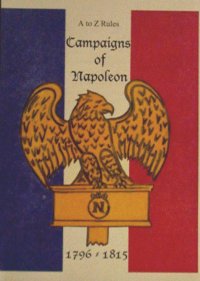 Check out the A To Z Rules Discussion and FAQ page
Check out the A To Z Rules Discussion and FAQ page Check out the A To Z Rules Discussion and FAQ page
Check out the A To Z Rules Discussion and FAQ page
Connecticut's snowy winter did not dampen the spirits of the CGC members that attended January 8, 2004 meeting in Stratford, CT. We kicked off the new year with a large battle of the Napoleonic Period hosted by myself. Here is the GameMasters after action report of the events. Followed by reports from Mark McLaughlin, the Emperor of France, and Brandon von Musler, Austrian Field Marshal and commander of the left wing division in the battle to be ever known as "Faulkner's Crossroads." The after action reports from the French and Coalition forces follows this recap.
One of our largest battles at a CGC regular meeting. Only our replay in 1994 of the Shiloh Battle, from the American Civil War, could compare in size. The armies were made up from collections from Mark McLaughlin, Tom Cusa, Phillip Spera and Andy Zartolas. The forces engaged on a 5 X 16 layout filled with rolling hills, marshes, deep sided streams, fenced fields, farm-houses, many bridges and a typical town around Dresden, 1813.
(antagonists clash at Faulkner's cross roads.
l-r Mark and Andy while John P. (hidden) John D. and Tom look on.)
French/German Order of Battle Mark McLaughlin Marshal of France Chris von Albrecht Marshal of France Brian du Smalls Field Marshal Mike von Pelletier Field Marhsal John von Passiglia Marshal of France James S. |
Austrian/RussianOrder of Battle Andrew Zartolas Field Marshal Brandon von Musler Field Marshal Eric von Drake Field Marshal Tomas Cusa Field Marshal Johann Demeter
|
Napoleon, after the devasting retreat from Russia, has quickly gathered together a portion of the forces defending his thrown and marched forward to meet the allies before they combined their armies. The armies of Russia and Austria were quickly coming together before the city of Dresden. Napoleon had to meet them and crush them in detail before they combined.

(The French Center at Faulkner's Cross Roads
sunken road on the right, the vineyard on the left)
The German and Wurttemburg Corps, commanded by John Passiglia and Mike Pelletier, would defend the French left, anchored on the extreme left by unpassable streams that fed into a marshy area, which was passable. the stream covered their front all the way to the vineyard and French center, then veered toward the allied lines, thereby splitting the Russians and Austrians into two separate forces. Strong-points included the town, which was cut in half by the stream, and a vineyard on a hill. The Wurttemburg Division place a battalion in the town on their side of the river, with the remaining battalions and artillery setup behind the stream, flanking the town and as a reserve line behind the town. The German division was placed on the vineyard and a second line behind the stream, the artillery was placed between the town and vineyard, creating a nice killing field that the russian would have to pass through.
The French center rested on a series of fenced grain fields that formed the crossroads of two major road arteries in the area. "Faulkner's" chateau and the windmill made up the second line of defense. Brian Smalls setup his artillery and battalions in this area with the German Cavalry Division, attached to his command, as a third line reserve group.
The French right was protected by Chris Albrechts French line battalions and the French cavalry division. They deployed behind a series of hills and a sunken road with the cavalry behind as reserve. The French right could have setup on a series of hills and fields with stone walls as protection but the Emperor did not want to over-extended his forces. This proved to be a mistake because the Austrians, instead of having to trudge their way through marshy lands and streams on the French extreme right, took advantage of the open area and quickly deployed into the stone-walled fields and hills left vacant. The French groaned as the Austrian Light Division developed a formidable defensive position that could have been theirs.
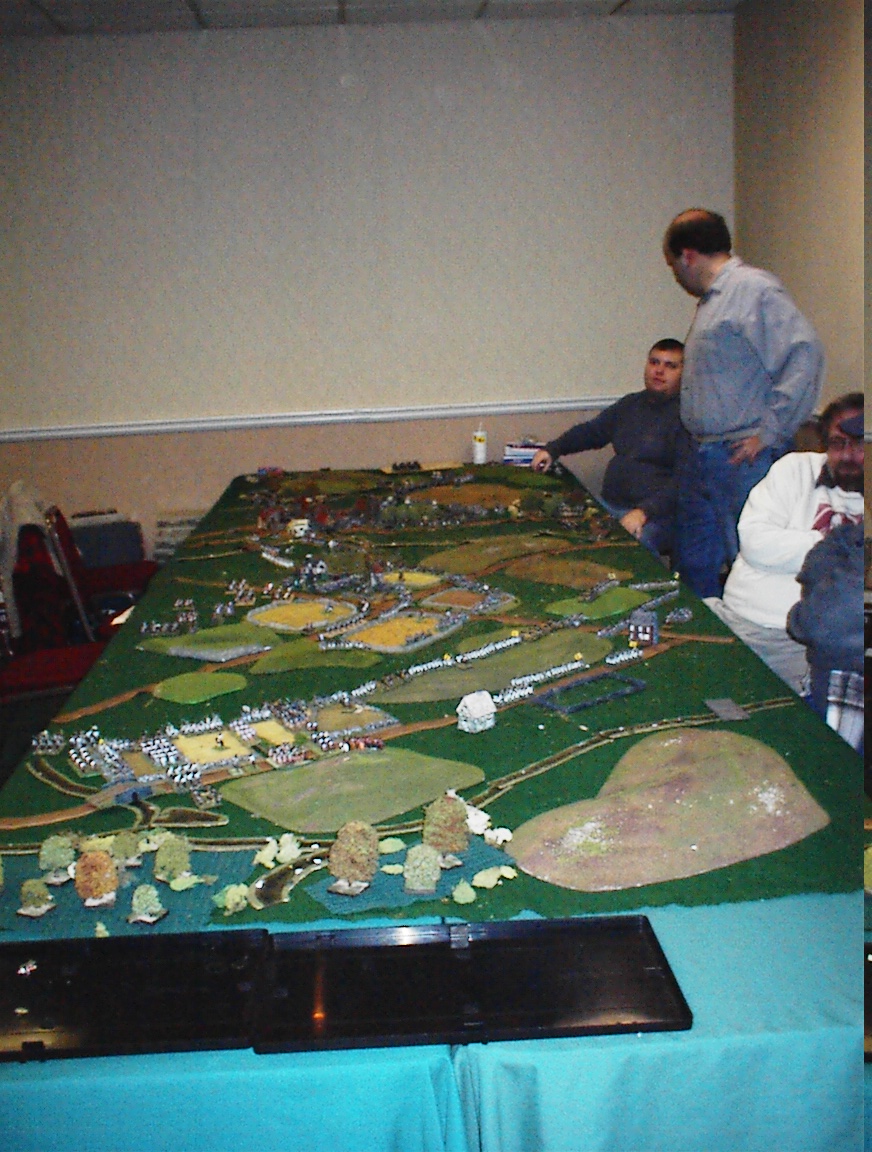
(Before the Carnage and Glory, the allies discuss strategy, l-r john d., tom, andy and eric)
The Russians came on in two wings. Tom Cusa held command of the left wing with orders to make contact with the Austrian right flank and take the vineyard, "if practicable." John Demeter took the remaining forces with orders to take the town. His arriving forces after crossing the stream, deployed with his left on the orchard in front of the church and his right to the marsh on his side of the stream, with cavalry on his extreme right with orders to cross the marsh and thereby flank the Wurttemburgs. the Russians were also allowed to setup a battalion on their side of stream and occupying the town. The battle commenced with the town under dispute and the remaining russian forces arriving.
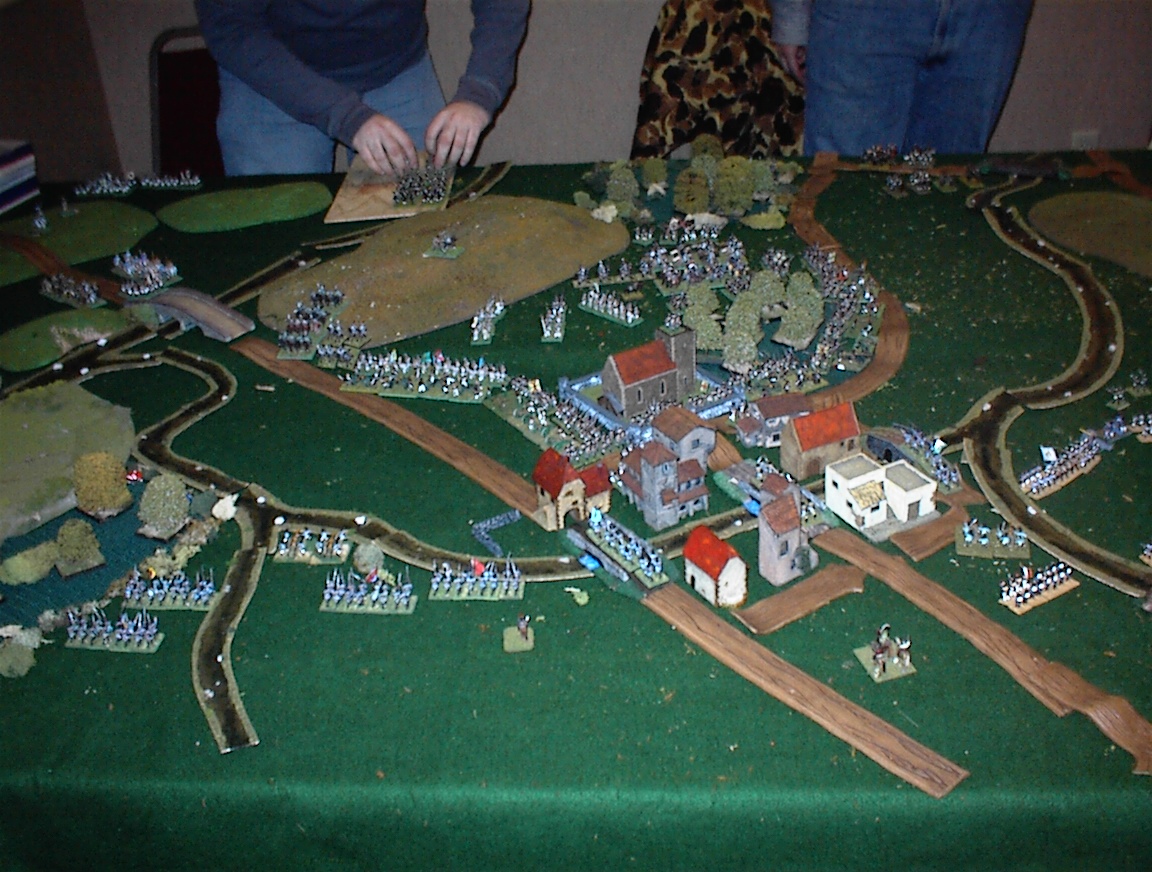
(The Russians Deploy, Wurttemburg Division in foreground.)
Andy told me that his plan of attack was the old hammer and anvil gambit. The Austrians would hold their position and demonstrate, taking advantage of any French weak points. While the Russians were the hammer, with orders to drive the enemy off the battlefield. Mark, never one to sit by and let his opponent dictate the action, would carry the battle to the enemy, with his guard as the battering ram. Vive l'emperor!
Seeing a weakness, Andy launched the first line of the Austrian cavalry upon the exposed French right. They quickly deployed on thier side of the sunken road and exposed extreme right, possibly catching the French cavalry in the flank. The Austrian horse artillery took postion above the sunken road and the guns roared with cannister at the exposed french infantry, which routed in turn from the withering fire.
The French quickly organised. The infantry formed line and advanced upon the sunken road, while the cavalry turned and faced the Austrian Cavalry advancing upon thier right. The Austrians, seeing themselves outnumbered and exposed fell back behind the heights of the sunken road. The French took possesion of the sunken road and hills defending it. Thus ended the Austrian demonstration.

(The Fall of the Town. Russian Columns assulting Wurttemburg infantry in square.
Russian cavalry on right attacking units in disorder.)
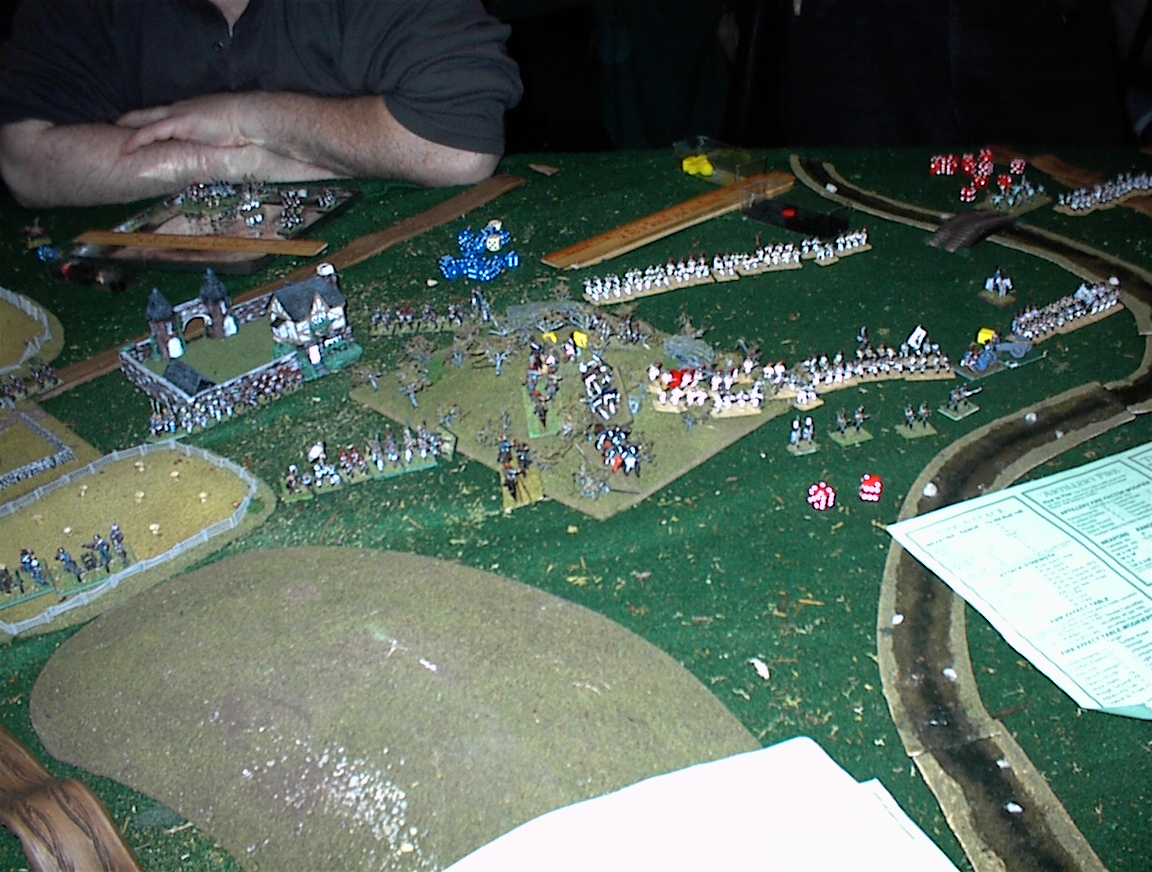
(Stalemate in the vineyard, Tom's Russian infantry and cavalry against Mike's German Division.
Faulkners' Chateau in the background on the left)
The plan was simple. Use the French artillery to decimate the supporting Austrian infantry, the light battalions would mass upon the Austrian grand battery and harrass the gunners till the guard grenadiers and line battalions closed in for the kill. First problem was that only one road was available. The entire line of advance was funneled unto this tract. Without room to manuever till they cleared the grain fields, the guard was an easy target for the Austrian artillery. devasting fire took out a guard 12lb battery and all but crippled another. Several guard line battalions took many casualties till the light battalions formed up in front of the Austrian grand battery. The second problem was that with the French artillery mauled, they could not force the supporting Austrian infantry to retreat. The Hungarians held their ground for the assault of the guard grenadier battalions which was now attacking fresh Austrian infantry and a grand battery of 12lbers.
With the guard light battalions as waves of skirmishers screening their manuevers, finally the guard grenadiers had an open area to deploy into their assault columns. Meanwhile the Austrians did not sit idly by. The second line of cavalry from the extreme left formed march columns and double-timed down the road to the Austrian center. Without hesitation they formed into squadron columns and charged the skirmsh screen. The guard skirmishers were helpless. Unable to deploy into square because they were in front of enemy artillery, they were forced to retreat behind the guard assault columns. The Austrian advancing cavalry reigned in, so as not to block their artillery from a now exposed target, the guard assault columns. Polish Guard Lancers now came up to support the columns, they meleed the Austrian cavalry only to be forced back.
Another round of cannister was laid into the guard, crippling several battalions. But the guard grenadiers advanced. Yet another round of artillery and musket fire into the columns, whole battalions withered away. The Guard advanced. A guard grenadier battalion reached its goal and destroyed the center of the grand battery on top of the ridgeline, thereby splitting the Austrians in two. Only one battalion reached its high-water mark. The supporting guard elements were wiped out.
"Now Maitlan." (quote from Wellington at Waterloo to one of his generals during the final moments of the guard's advance) And the Austrians second line of infantry advanced....
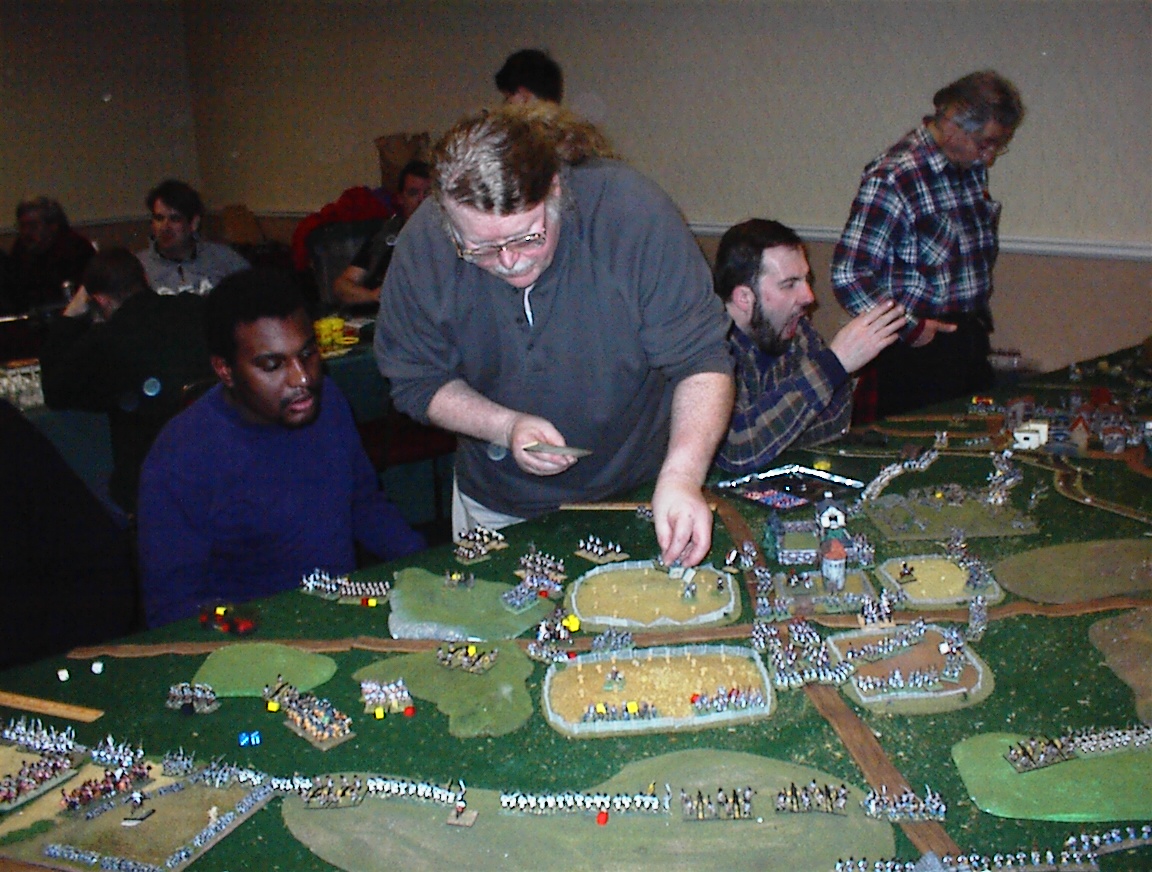
(French Guard advancing through Faulkner's cross roads, l-r: Brian, Mark, Mike and John P.)
It is said that, during the spring of 1813, Napoleon insisted all toasts to his health be made with Spanish wine. Fresh from humbugging "that Sepoy general" (Wellington) in Spain, Napoleon hastened east to defend Dresden, a crucial fortress on the eastern frontiers of his Empire, currently under threat from multiple Allied forces.
There had been a setback on the Nieman while he was absent sorting things out in Spain, but it may have been a blessing in disguise. It was advisable not to overextend his army's resources. Napoleon had left the remnants of the British Army cowering in Portugal. And the only proven Russian general – Kutusov – was dead. So, despite years of squandered momentum, French prospects shined brightly once again.
With a reinforced Russian corps marching down on Dresden from Berlin and the Austrians approaching from the south, the Emperor saw the chance to save the Confederation of the Rhine and cover himself in glory. Indeed, when the vanguard of his German allies pushed across the Spree River and into Glein, an obscure town near Bautzen, visions of Austerlitz and Jena-Auerstadt danced in Napoleon's head like so many sugarplum fairies.
Glein sits at the base of a cul de sac formed by the Spree. The Russian corps was occupying it. Although initially surprised by the impetuous Allied advance, Napoleon greedily gathered all forces at hand: fourteen batteries, five infantry and two cavalry divisions, including the Guard. He was anxious to crush the separate, smaller Allied armies before they had the chance to link up. Understanding that the new Russian generals had chosen excellent terrain and knowing from hard experience how stoutly their army defended, he tasked his two German divisions to screen the left and turned his attention south.
There the Austrian army, under an unheralded Greek general named Zartolas, was quick marching toward Glein.
Exploiting his cavalry superiority en route, Zartolas gained excellent intelligence of the French dispositions. Perhaps wary of restless Russians, Napoleon had – uncharacteristically – left his right flank hanging in the air. Zartolas urged his best troops forward. They grabbed the high ground – called the Burk – above the road back to Dresden. There they stood on the extreme left of the Austro-Hungarian line, poised like the sword of Damocles on the French jugular…and so the battle was joined.
The opening stage of the battle saw action on both flanks of the French Army. General Demeter swung Cossacks north around the extreme left of the French line to look for a place to ford the river. General Cusa pushed southwards to secure a bridgehead that would make combination with the Austrians possible. Resistance to this foray was slight but Cusa ran the risk of advancing into a trap. A counterattack from the French center could pin his bifurcated forces back against the river while the balance of Cusa's command was busy supporting Demeter's primary thrust at the center of Glein. There the 2nd and 3rd Russian infantry divisions pounded against the German lodgment on the East Side of the Spree.
On the southern half of the battlefield, despite his powerful position astride the French lines of communication, General Zartolas was not content to rest on his laurels. He called upon his cavalry again. They conducted a reconnaissance in force amongst the steep defiles on the French right. As fate would have it, Napoleon had stationed the bulk of his cavalry, including elements of the Guard, across the key roadway.
Large-scale skirmishing ensued. Both sides brought horse batteries to bear. They played peek-a-boo along the ridgeline until two Austrian regiments impulsively charged General Albrecht's mobile cannon. The French 4-pounders were spiked but not without first being ably served, which rendered the Austrian cavalry units hors de combat for the remainder of the day.
First blood had been drawn with little meaningful result. The question of how long the German commanders – General Passiglia commanding the Wurttemburgers opposite Demeter, and General Pelletier with the German division in the center across from Cusa – could delay the Russian steamroller remained unanswered.
Control of Glein remained in doubt; indeed, the only thing clarified by the initial fighting was that the southern ridgeline along the supply road was a formidable obstacle discouraging significant advancement by either army. The Emperor would have to test the center. The operative issue for Napoleon – who bore the onus of attack – was which center to try. The regular Russian cavalry was only just testing the Spree on their way to filling the vacuum opposite the French center. The Austro-Hungarian line was ensconced on the series of hills comprising the Burk, replete with the Corps artillery.
The Emperor, long an advocate of big battalions, knew how tenacious an Austrian gun line could be when its flanks were secure. Napoleon's specific intention remains less than clear at this juncture. This much is known: in lieu of pivoting General Mike “Mad Dog” Pelletier over to the attack against the advancing Russian 1st Division, he summoned forth the Guard for an unusually early deployment. They marched straight up the main turnpike from Dresden toward General Drake's Hungarian division.
Now the fortunes of war grew fickle. Both Drake and the commander of the French Guard, General James, were dispatched by trigger happy Austrian Jaegers. Before his accidental demise, Drake had positioned his division to block the main road on the right of the Austrians. This was, of course, the pathway along which the Guard advanced.
James' actual orders were never found and Napoleon remained mute on the subject until his dying day. Did James intend to turn against the Austrian line or pivot into the still yawning chasm between the Russians and the Hungarian division? In any case, his demise could scarcely have been less opportune for the French vanguard.
Advancing in road column formation, an infantry battalion and both batteries of Guard artillery missed their turning. Instead, they marched straight into a maelstrom of 12-pound ball when the bulk of the Austro-Hungarian artillery barraged them to destruction. This was a catastrophe from which the French ultimately never recovered but to the sorrow of the other Guard formations – oh how Napoleon tried!
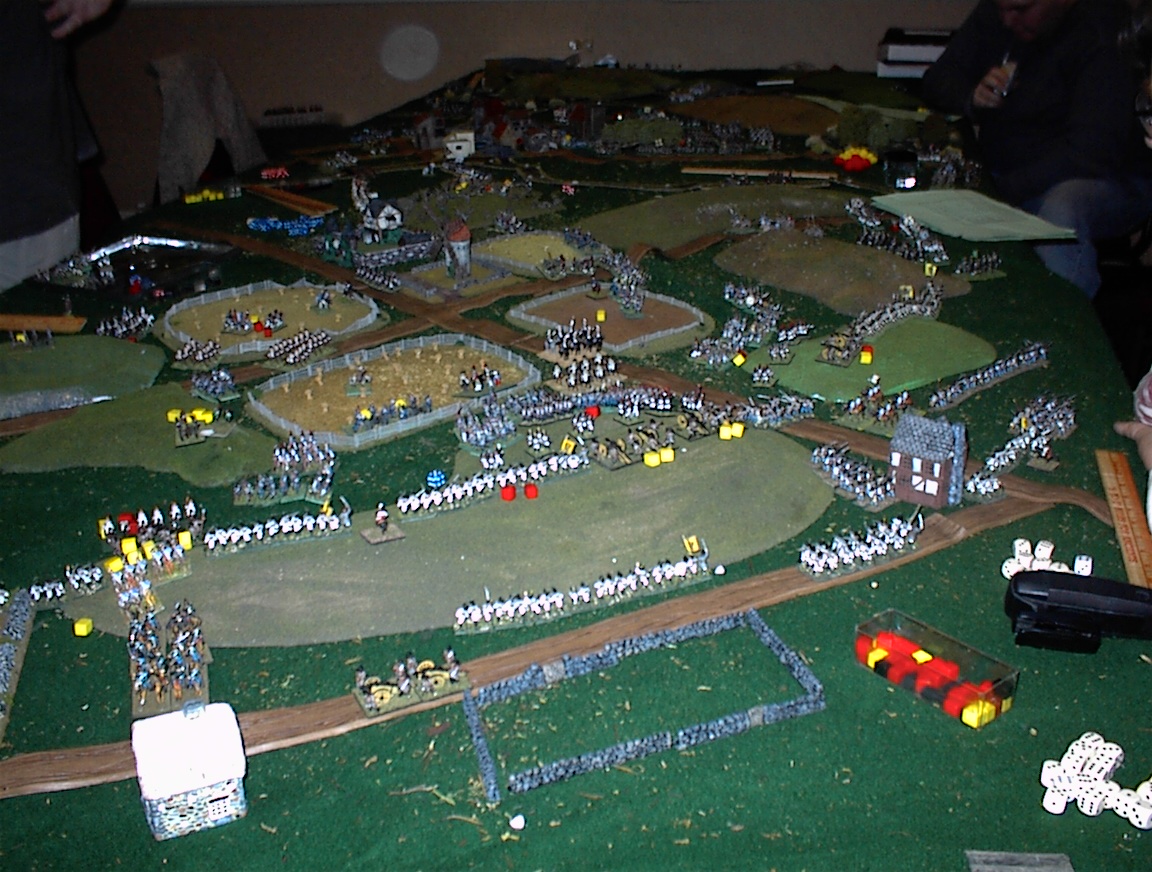
Portents of doom, dressed as German Adjutants and French aides de camp, had been arriving all afternoon at Napoleon's headquarters. Russian Cossacks and cavalry had crossed the river on both flanks and Demeter's infantry was bludgeoning its way through East Waterloo, evicting the Germans.
Time and again Passiglia's bruised and badly outnumbered battalions formed square only to be broken again…there lives forfeit as the price of Empire. Opposite Cusa's troops, “Mad Dog” Pelletier remained uncharacteristically passive. One diary implies he was, in fact, dallying with a maiden – a fatal character flaw that frequently marred his otherwise glorious career.
Sensing the moment of decision was upon him, Napoleon galloped to the head of his Guard. Whatever his prior plans, there was no time now to realign the army or even redress his lines. Seizing an Eagle, he personally led them to the base of the ridgeline where the Young Guard shook out into skirmish formation, the middle and Old Guard in column of attack behind.
Flanking them were Dragoons on the right, Polish lancers on the left and a single 8-pound field battery in support. Knowing the odds, he scaled part of the hill so they could all see him. Turning his back contemptuously on the enemy, he doffed his tricorner hat and gave them his deepest bow. They raised a sobbing cheer and when a cannon ball skipped lightly by his legs, they spontaneously surged forward. For liberty, for equality, for fraternity? No. Only for the Emperor!
General Zartolas remained ignorant of this display. Hearing of Drake's death, he had ridden to the Hungarian division. In fact, he was taking lunch on the far side of the ridge that the Young Guard assaulted. The Hungarian battery sent repeated requests to open fire on them, but Zartolas disdained to glance up from his goulash: “Don't waste powder on skirmishers.” The Austrian artillery did fire – canister – ripping huge gashes in their screening line, but the Young Guard hardly flinched.
Despite their losses and while still in line of skirmish, the survivors delivered a withering volley that cut down the Hungarian gunners. They abandoned their guns to the Young Guard who hadn't finished with the Hungarians yet. Fixing bayonets, they advanced on the supporting infantry and routed them as well. As they fled, the routed battalion yelled warnings at Zartolas' tent.
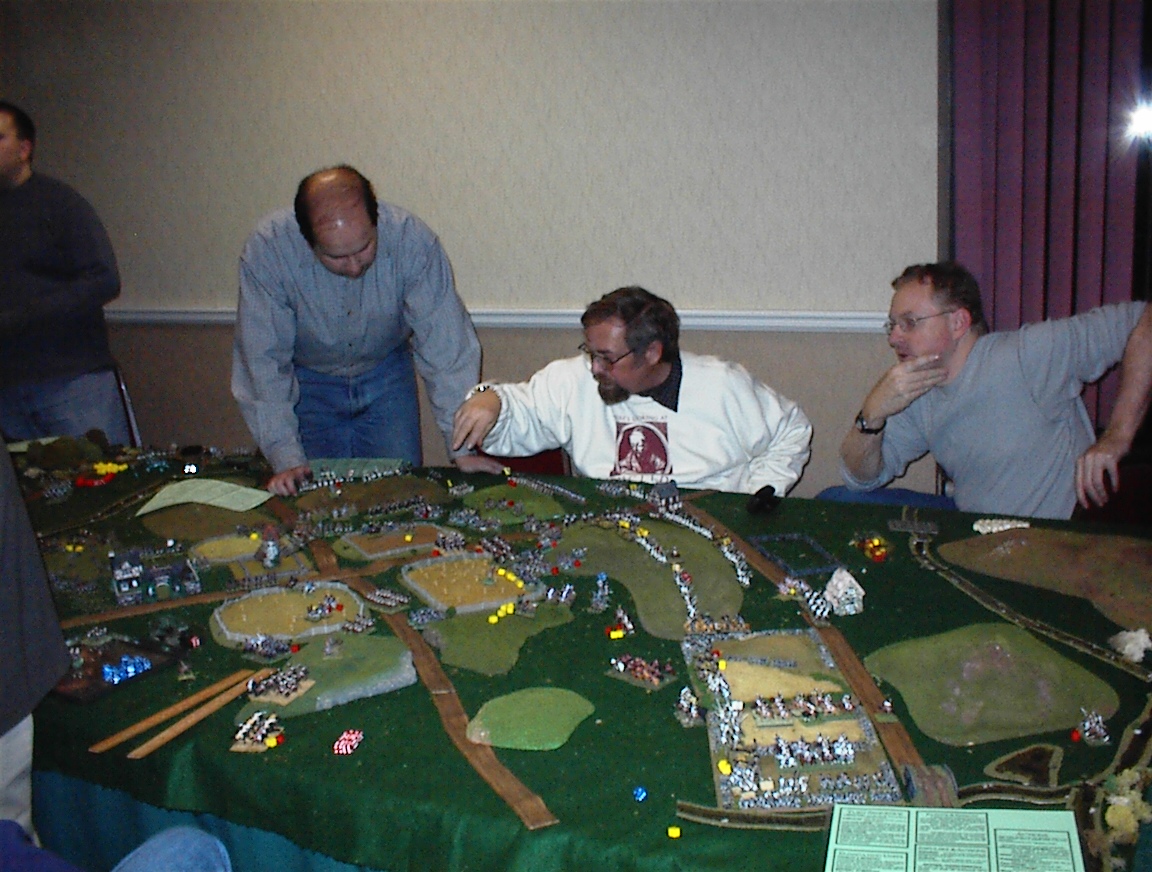
(the Russians link up with the Austrians during the height of the French Guard Advance. l-r Tom, Andy and Brandon.)
The battle, beyond any General now, devolved into charge and countercharge. Austrian Jaegers and Hungarian cavalry charged to restore the line. Dragoons demonstrated before the guns. Polish lancers rode across the gap and up the hillside. An Austrian battalion was forced into square around General Zartolas who screamed defiance from within.
The Polish Lancers veered left into the Austrian cavalry. A melee ensued until Cusa's Russians appeared over the neighboring hill, forcing the Lancers to retreat. Through all this and a dozen other unheralded actions on that ridge there was one constant:
But the guard came on
Through shot and shell and 12-pound hell
The guard came on! *
Crying “Vive L'Empereur!” they flattened a fence and deployed at the base of the hill. Suffering through a hurricane of first ball and then grape, they slogged up the slopes, defeating multiple charges on the way. After breaking one last Austrian battalion the bloodied remains finally attained the crest.
It was a glorious advance, but unsound. As the Old Guard battalion looked down on the road running along the reverse slope of the hill they saw below, yet another battery of 12-pounders, flanked by two battalions of supporting infantry awaited. Their attack was kaput.
Half the French Army saw the Guard traipsing back down the Burk and the cry went around, "The Guard retreats!" General Smalls organized a rearguard that did its best to fend off pursuit, but his 2nd Line Division and the two surviving Guard battalions were insufficient.
General Demeter's forces, having by now driven the Wurtemmburgers from the field, closed the sack. Cusa's Russian kept the pressure on in the center. Zartolas unleashed his remaining cavalry, plus the Austrian Light Division from the Burk to cinch the noose tighter. When it was over the French had suffered eight casualties for every Allied loss. **
So, in the autumn of 1813 the Emperor was dethroned for the first time.
*A vacationing tavern keeper named McLaughlin who was on the road to Dresden wrote this doggerel. He was likely there to sample beer, but has otherwise been lost to history.
** From Spera's "Historical Forensics," regarded as the foremost study of the battle.
In struggling to find the best explanation for what happened in the big Napoleonic battle at the Connecticut Game Club's January meeting I turn to Faulkner.
In his 1948 classic, Intruder in the Dust, the Pulitizer prize-winning novelist wrote that:
"For every Southern boy fourteen years old, not once but whenever he wants it, there is the instant when it's still not yet two o'clock on that July afternoon in 1863, the brigades are in position behind the rail fence, the guns are laid and ready in the woods and the furled flags are already loosened to break out and Pickett himself with his long oiled ringlets and his hat in one hand probably and his sword in the other looking up the hill waiting for Longstreet to give the word and it's all in the balance, it hasn't happened yet, it hasn't even begun yet, it not only hasn't begun yet but there is still time for it not to begin against that position and those circumstances which made more men than Garnett and Kemper and Armistead and Wilcox look grave yet it's going to begin, we all know that, we have come too far with too much at stake and that moment doesn't need even a fourteen-year-old boy to think This time. Maybe this time with all this much to lose and all this much to gain: Pennsylvania, Maryland, the world, the golden dome of Washington itself to crown with desperate and unbelievable
victory the desperate gamble, the cast made two years ago..."
Now, imagine instead if Faulkner had been born in the south of France, and instead of writing about Lee and Pickett he wrote about Napoleon and Ney....
....and then we gamed it out.
The situation at the club was very 1813. On one side, a French army. Of its five division commanders (bryan, john, mike, james and chris), few had ever played napoleonic miniatures and none had ever played A to Z Napoleonics -- although one, amazingly enough (chris), had actually the rules. Talk about your Marie-Louises being trained on the march.... (gm: before the game began I asked the players which side they wanted to play, John Passiglia wanted to play the Wurttemburgs, Brian on the side with his buddy Mark, and Mark insisted that he be the emperor, while James, Chris and Mike requested to play on the French side. On the Allies, from the outset, Andy was to play opposite Mark, Tom had his Russians and wanted be Russian, Eric and John Demeter had to play the allies to balance the players envolved. GM agrees the player experience was balanced in favor of the allies. However, unit wise, the numbers were about even except the Allied had 2:1 cavalry superiority. The French were all veteran and elite morale, The Germans were regular morale, The Russian/Austians all regular morale exept for the Austrian Light Division of Veterans.)
Their commander in chief (Mark McLaughlin) was a veteran miniatures and napoleonic gamer, but one who had not had the opportunity to play these rules in about a year and half...but in the land of the blind, the one-eyed is....emperor.
The army itself was a fair one. Two German and two French infantry divisions, a German heavy and a French light cavalry division, and a French Guard infantry division....35 btns, 10 cav rgts, 14 batteries. Their largest disadvantage was not knowing where the enemy was, or how big he was. Add to that the need to deploy first on the table...and a big table.
The situation was made a little worse by knowing that they had to break the enemy to win; all the enemy had to do was avoid being broken.
Some would call this the onus of the attack; in the French army (or more acurately, as McLaughlin understands the French army) that is merely standard operating procedure.
The French choose to deploy mostly in the middle of the table, in a salient: the two french divisions formed the sides of the V; the cavalry brigades its right anchor. its left anchored on a small hill held by a german divisions that covered the hill to a river. to their left, across the river, lay a town, itself divided by another branch of the river. the other (smaller) german division held part of the town, with a lodgement on the far side of that river. a battery and some infantry were deployed to the left of the town, on the french side of that river, their flank resting on swamps.
The guard, off the table at start, was to march on inside the V, covered by the deployed troops, ready to swing left, right or go up the middle, depending on the whereabouts of the enemy.
Well, the enemy appeared, and in spades.
To the front and to the right of the V, on the ridges and in the fields with the stone fences appeared a very large Austrian corps; rich in cavalry, well supported with heavy guns and composed of very large battalions (it took four hits to eliminate a base of an austrian unit; as opposed to three hits to kill any other army's base).
This formidable force was led by Andy Zartolas, the A and Z of A to Z rules, and a past master of the game he wrote....and perhaps the finest tactical mind for miniatures in the club.....his able assistant was Brandon "hot dice" Musler....a man who, as his rolling
showed, should have left the table and taken a limo to Foxwoods....
Opposite the town a large russian corps with a massive amount of artillery appeared. John Demeter and Tom Cusa, two veteran gamers who often ride into battle as Andy's wingmen, led the Russians
Two battles developed.
Battle one was the German-Russian battle, or, as it was known in the Napoleonic camp, Horatio at the Bridge, with John and his Germans playing the Horatio against the Russian horde and its hub to hub artillery charge.
That John held on with his small weak division for four hours is a tribute to his tenacity.
Mike and his Germans held their line, too -- Mike, or "Mad Mike" as some call him, performed ably, getting numerous high fives and congratulatons from the French players for hanging on.
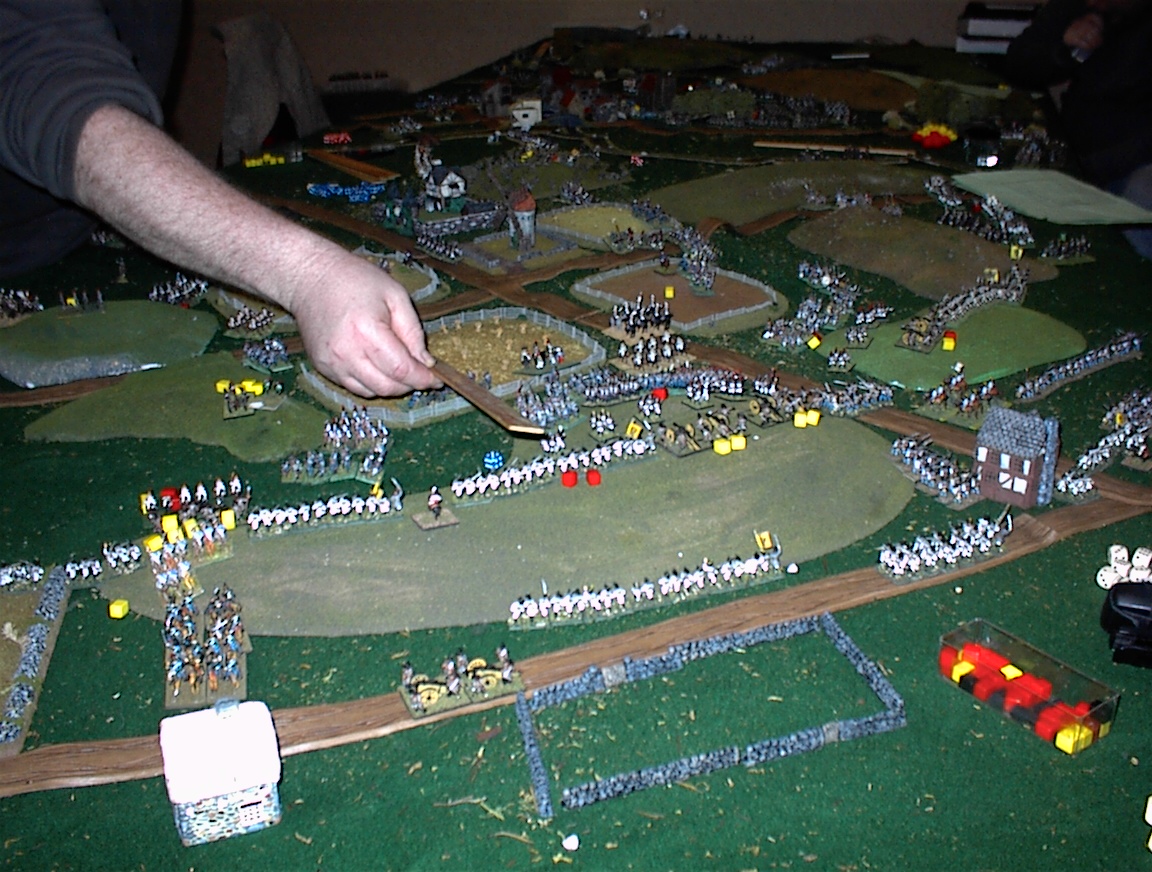
(measuring up the Guard)
The Austrian cavalry and horse artillery sortied and after a short back and forth duel with their imperial counterparts pulled back to their line. This left a no-man's land on the right, with Hungarian infantry and artillery defending a line of stone fences backed by cavalry on one side, and a ridge behind which the franco-german cavalry was martialled on the other.
The guard marched up. fences and fields and a long way to go up a single road canalized their movement. Unfortunately, instead of veering off to the right, toward the long ridge held by the Austrians, they drove straight up the road, which was covered by three batteries of Austrian 12-pounders on the hills.
....but the guard came on.
...through shot and shell and 12-pound hell.
the guard came on.
...and deployed.
young guard skirmishers shaken out to the front. old and middle guard in column of attack behind. line infantry at the ready behind them.
German dragoons on their right, polish lancers on their left, and a single 8-lb field battery in support (as the guard artillery had been destroyed as it raced up the road)
--and over the fences
--and to the base of the hill
--and through the ball and grape
--and ready to go up.
---and then the allies won the initiative die, and their cavalry hit the skirmish line (which fell back safely behind the columns) and left the columns exposed to 12 pounder grape at close quarters.
--and then the guard battalion on the left was hit on the left by jaegars in attack column...and the guard held, only to be ridden down by cavalry...
--and then the Russians appeared, coming over the hill to the left....
---but the french line held, and up the hill it went.
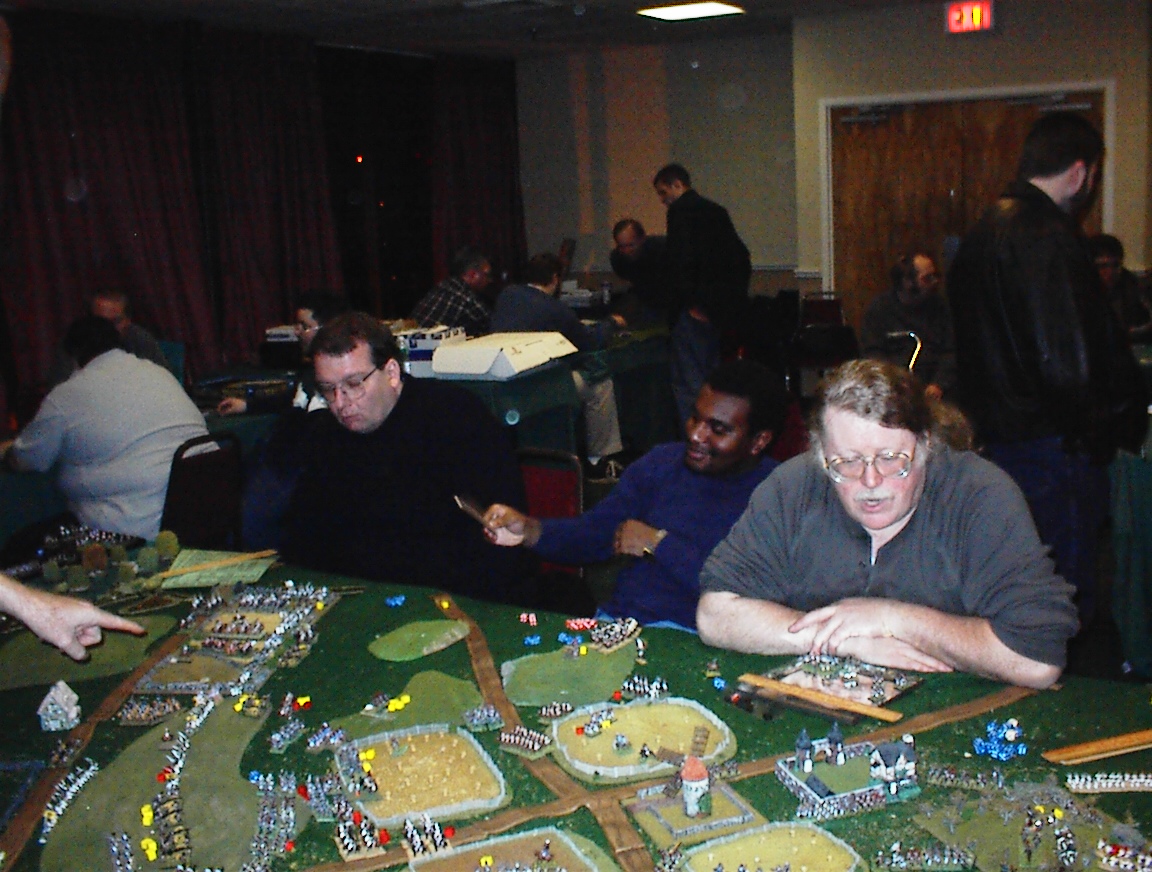
(Measuring the French command. l-r Chris, Brian and Mark.)
Polish lancers rode down the gap and up the side of the hill...but the Austrians got into square, their general sheltered inside. the lancers rode on into the austrian cavalry and meleed with them, only to be forced back.
but the guard went up the hill...to death, or glory,
depending on your point of view.....
----and one battallion got through all the grape and musketry and reached the middle of the ridge, to plant their eagle....
and to look down behind the ridge at the rest of the Austrian army.
...and there ended the battle....at the Napoleonic equivalent of Gettysburg's copse of trees, the high water mark.
---Could the French have won?
Like the 14 year old boys of Faulkner's youth, they thought they could....and if given the chance again, they would try, again.
---and make Faulkner weep.
vive l'empereur
Dear Deposed Tyrant,
I suppose being on that little island, there's not much else to do. And it wasn't a bad summary, but launching that pre-emptive literary strike will hardly save you from a more fulsome treatment by the unforgiving eye of history. I stood bravely on the hill beside Sir Robin and the rest of my men watching your battalions melt like ice on a summer's day. It was magnificent, but it wasn't the way us professionals fight a war. That's about all we'll be hearing from these unwieldly "democratic armies." You must always remember Mark that it's the victors who get to write history.
In my memoirs, it won't be luck that doomed the Guard! Having got a bit too cocky beating up on that "sepoy general" in Spain, you forgot about what Frederick the Great taught us...and it will never change.
God Save the Queen...or King...or the Knights who formerly said 'nee'...but now say echi, echi, echi, akaw...ptang.
Yours smirkingly,
General Brandon "Hapsburg" Musler
An Early Advocate of the Austrian-Hungarian Empire
P.S...which is less anachronistic than Napoleon quoting Faulkner about a war as yet unfought. (Get some sleep man!)
Had a great wargaming day at the CT Game Club in Stratford on July 8. Like old times, me with Frenchman with sabers and bayonets (hardly fired a bullet all day, just good old cold steel)..
We played the Napoleonic battle of Caldiero, 1805. The battle between Archduke Charles and Marshal Massena did not turn out like the real battle in Austria of that name -- it was more like Assaye.
We used hordes of 15mm troops from the collections of Phil Spera, Jon Baldwin and Andy Zartolas. We used the A to Z Rules for the Campaigns of Napoleonics (simple rules) written by Andy.
The Austrians were deployed in a strong position. Their right had a line of hills with a fordable river in front of it. Their center had a walled town. Their left had a small village flanked by strong works to either side, with a fenced farm farther down the road to anchor the left...with a little open space beyond for light troops to play around. The Austrian left had field guns in one work and howitzers in another, with a horse battery on the flank and another in reserve. Their right was similarly well supported with guns.
The French were not French, but Italians (thus almost all troops were regulars, with the only veterans being a pair of grenadier btns and two dragoon rgts -- our heaviest horse)(Phil: The "Italians" were French. The GameMaster believes that French forces not directly under Napoleon would not have the same elan or fighting spirit as when in front of their emperor, therefore the unit morale ratings equaled the Austrian's). Our biggest guns (three batteries) were 8 -lbers. We had one six and a pair of 4-lb, one of which was a horse gun. The French were also outnumbered, and were on the attack.
We deployed three of our four infantry divisions on the right, opposite the enemy works, with the dragoon brigade on our far right . The fourth and smallest division marched to our left, to a small hill we called "Le Speed Bump." Our Reserve consisted of the light cavalry division -- 5 regiments of cheveau-legere.
The Austrians won the toss to go first....and did nothing. They saw our deployment and waited. We came on in column of attack, guns limbered, with the only two btns of skirmishers in the army deployed as best we could. We kept all the horse, even the lights, in column of attack. The second turn the Austrians again won the toss...and again did nothing. They were so confidant! They did not even fire guns in both phases (theirs and ours), but elected to rest their batteries on their own fire (in these rules each time you fire you get a fatigue chip, and roll less dice, unless you rest to remove it).
The third turn we unleashed hell.
We charged straight in on the works. Their guns slaughtered our lead columns. Our second line walked over our own dead, while their guns were reloading, to slam into the infantry behind the works. We took dreadful fire from muskets, but we closed and our columns drove them from the works. A one-two-three
wave cavalry charge by our reserve light cavalry at first did not fare too well -- one regiment failed to close and stopped right in front of a line of Hungarians who disdained forming square, lest we ride past it into their limbered guns. A second regiment defeated one unit of enemy infantry, only to leave the table in pursuit of them. The third regiment...ah, th
It scattered one infantry unit, rode down another, disordered one that had been pushed out of the trenches, fended off a countercharge by Austrian horse (that were so desperate to engage us that they came across a stream, in disorder, hoping to slam us back...but did not).
The next turn, we won the toss, and pushed the slaughter in the center, overrunning one battery, chasing another off, riding down more infantry....while our third line of infantry came up into the works and started working on the line the Austrians were hastily trying to form.

And then the Austrians really crumbled, as our right flank commander, "Hot Jon" unleashed his cavalry. His cheveau-legere were halted by Austrian Hussars, but our first dragoons rode them down, followed them through the enemy horse artillery (whose gunners abandoned their guns), chased off Croatian skirmishers and then slammed into another Hussar regiment -- which they annihilated. The other dragoons came forward in support while the horse gun broke an Austrian Uhlan regiment.
On our left, Le Speed Bump was getting warm, so the commander there sent his one light horse unit to charge the Austrian cavalry coming over the river... and used that to buy time to bring his division back to our center and anchor our attack.
The next turn was the last for the Austrians. We pushed forward again with our tiring units, pushing the Austrian left back again. The Austrian right wing cavalry defeated our little rear guard, but rather than try to swing his ponderous infantry around behind them, John Troise formed up his supporting infantry into road column and dashed up the road, into the town, heading in column of march to the rescue....
At which point Charlie, le club prez, who commanded Le Speed Bump and the Reserve Lt. Cav, drove his horse gun up to the road, unlimbered it and canistered the head of the Austrian column. The lead regiment broke. Having nowhere to go in the crowded streets but back, it ran into the regiment behind it, which ran into the one behind that.
At this point the Austrian commander Mike Pelletieri (or better yet, the one left in command, as the original commander Joe Mallory had long since departed), handed me his ruler as a sign of surrender...
It was glorious. A pure Napoleonic moment.
What a day!
(Next week in Manchester I get to be on the Austrian side when Phil puts the game on again). (players in game included, Jon Baldwin, John Covello, a CGC old time regular now back in town John Demeter, Joe Mallory, Mark, Mike Pelletieri, Charles R., Mat Roos and John Troise.)
When the names of the three people playing the Austrian side in a Napoleonic battle are Charles, John and Mac, you know the omens are not good. Despite that, the Austrian army put up what at least three of the four French commanders declared was a hard-fought battle for five hours at the July 15 Manchester meeting of the Ct Game Club.
The Battle was Caldiero, 1805, a rematch of the same fight Phil Spera set up at the Stratford meeting on July 8. Mark McLaughlin (whose high school nickname of Mac has come back to haunt him) took command of the Austrians, and Game Club President Charlie, who did so well with him as the French in their glorious victory of July 8, joined him - along with John (Demeter) the Younger -- who had suffered as an Austrian the previous week. Opposing them were Andy Zartolas, author of the rules, Greg Dzurbay, "Jon is Hot" Baldwin (who performed so brilliantly with the French the previous week) and Roland Fricke playing the French right flank, a newbie to Napoleonics.
As before, the Austrians deployed first. This time, however, the fordable river ran across their entire front. The Austrians gave up the extreme right and instead placed one mixed division in the village on their right center -- but instead of occupying the entire village, garrisoned only that half on their side of the river. Two light cavalry units and a howitzer battery from the division stood on the hills behind the village, leaving its defense to two battalions of infantry.
In the watery gap between the village/hill and the trenches and gun platforms of the left center, a lone Austrian infantry division was stretched. That left four divisions on the left and left center: one in the works, with columns ready behind it, and a second division next to it. The light advanced guard division formed the extreme left.
The Austrians agreed they would not sit still. They would attack in either the left, left center or center, depending on the French disposition -- or at the very least, would be ready to counterattack should the French match them weight to weight.
Crafty Zartolas, Marshal of France, massed his three eight pounder batteries in his center -- opposite the thin-stretched Austrian division, thus effectively making a no man's land in the center. He sent his cavalry division and one infantry division to his far left, to sweep across the river and up the valley to outflank the Austrian town, while another division was sent straight toward the town itself. A fourth division was deployed around the grand battery -- half to protect the guns, half to support the village attack. The French right had the other two divisions, with the far right anchored by a battery on a hill, supported by the only heavy cavalry
(dragoons) in either army.
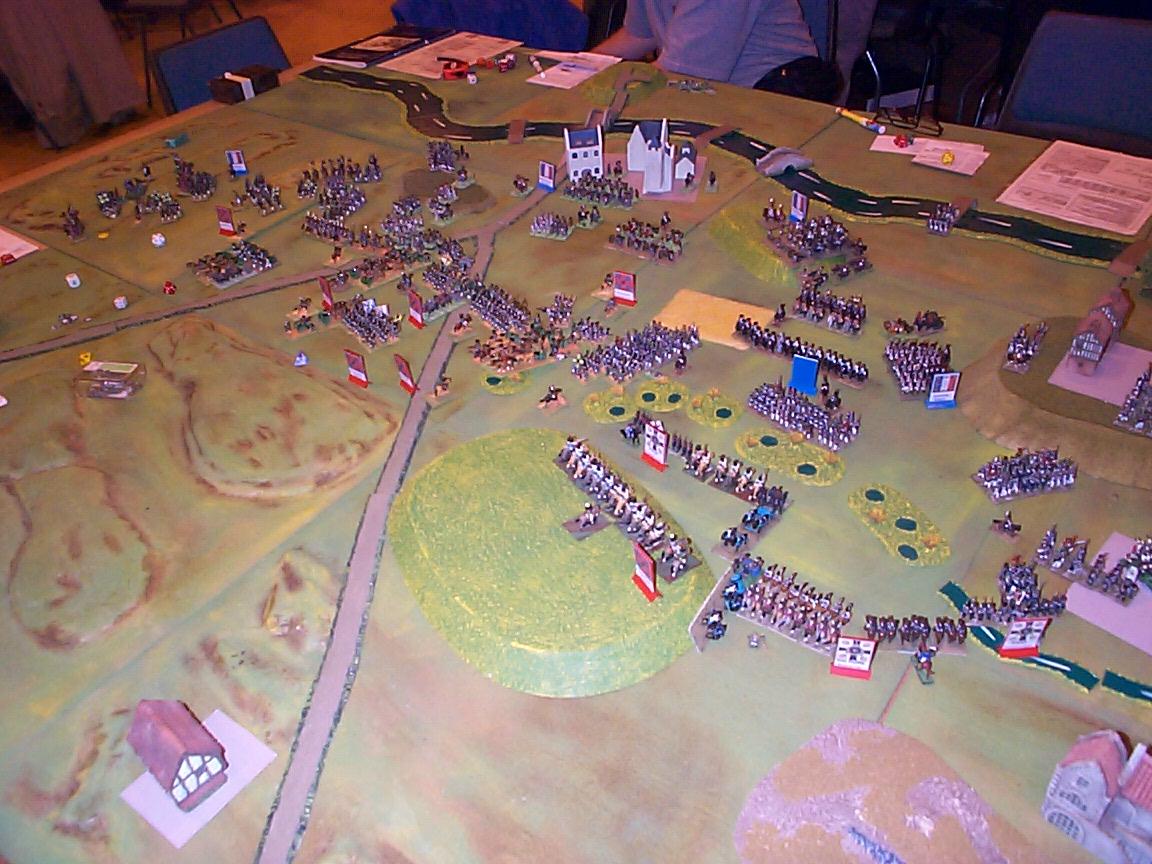
The battle opened with an Austrian advance -- in the dead zone of the center. The Austrian division in the open had no where to hide, so it was sent toward the French, thus enticing them to unlimber and blast away at it -- rather than come closer to support the attack on the village or move to the french right, where the main Austrian assault was set. The French grand battery made quick work of the Austrians: within three turns two regiments were destroyed, a third severely weakened and a fourth was enticed to head toward the town (out of the arc of the guns) to duel with french infantry. A lone regiment stayed as a target.
The Austrian move on their left was slow in coming off -- the river, tho fordable to infantry and cavalry at half move, had only one bridge for guns. The Austrians began to move across, but immediately ran into heavy fire from French guns, followed by some superb charges by the French cavalry. A swirling, bloody and confused melee of charges, countercharge, flank attacks, hasty squares, horse battery charges, overrunning of guns and units went on four hours. As the French commander on that flank put it "we kept killing them but more kept coming!"
Charles and John worked well together, using all the bonus commands of the c-in-c to help move their forces around the works, over the river and up toward the hill.
in the meantime, Greg's French division occupied the undefended side of the town and became involved in a vicious firefight with the Austrians-- and took the worse for it, although by judiciously pulling back weak units and sending fresh troops in, kept all but one of his units in the field. "Hot Jon" made slower progress around the flank, made worse by the Austrian howitzer battery which, alone, took out one regiment of infantry and another of cavalry. Jon came in close only to face a furious cavalry assault by two Austrian Hussar regiments. The French lost a horsegun and a cheveau-legere regiment to Austrian sabers, and took such other losses as to put them in disarray for two turns. Efforts by Jon to kick his horse to charge met with an unfortunate series of morale failures, but, eventually, his numbers and
momentum began to tell.
The crux of the battle came on turn 10. After four real-time hours of fighting, both sides had lost 12 units. (Three more and the French would break, 6 more and the Austrians work break). That turn, everything went well for the French. On the hills to the right, the French cavalry, although hit in the flank and outnumbered two to one, pulled off a miracle as their dice returned -- and Austrian dice deserted. Zartolas's half-division hit the town on one side, Greg's division fired from the front while "Hot Jon's" grenadiers hit it from the other side. Although one French unit was repulsed, the French took the town. The howitzer battery on the hill missed three rounds of grapeshot entirely, and although its gunners fell back into an Austrian square when the French cavalry charged, the square disappeared under a hail of French musketry from supporting infantry that broke through the town.
With the collapse of the Austrian right (including its general), the French had a nice, warm toasty feeling that seemed to carry over to their dice on their other flank. There, the Austrian attack finally hit home. A French line unit, at full strength, declined to try to form square when charged by Austrian hussars. Levelling their muskets, confident of blowing away the weakened hussar unit, the French paid the price for their pride when their shots missed. The line unit evaporated under the hussars' sabres. The Austrians pushed forward all across their left -- and then everything fell apart. Zartolas, having cleared away the Austrian grenzers who were harrying his grand battery and with no targets to his front, sent his Marshal to personally bring some eight-pounders to support the decimated French right flank.
arriving at the true nick of time, they broke the Austrian breakthrough with grapeshot.
Austrian units, weakened by heavy fire from French guns and infantry, failed morale checks to close with the enemy and melee-- and were caught up short, in the open, for the next French fire.
By the end of that turn, 8 more Austrian units were gone from the table -- bringing the total to 20, two more than needed to break the army.
Twere the kind of hard fought, tense, close battle that even those on the losing side cherish playing.
To Mark,
"That was truly a memorable game...your decision to attack so vigorously caught me completely off guard...it was a wonderful day of gaming...you always prove to be a talented and exciting opponent, win, lose or draw......I'm glad we got the opportunity to play..." Regards, Andy Z.
ps: good catch on the Mac, Charles and John bit...I failed to notice that...how ironic.
"In war, morale considerations make up three-quarters of the game:
the relative balance of power accounts only for the remaining quarter."
Napoleon Bonaparte